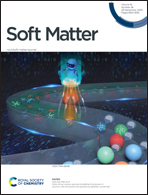Recovery of the self-cleaning property of silicon elastomers utilizing the concept of reversible coordination bonds†
Abstract
Stretchable elastomers with superhydrophobic surfaces and self-cleaning abilities are fabricated for use in wearable electronics. However, scratches or ruptures are inevitable on these elastomers, thus deteriorating their self-cleaning ability. To solve this problem, in this work, we explored the ability of a self-healing silicon elastomer to recover its self-cleaning property. A cross-linked silicon elastomer (Zn-IC-PDMS) was fabricated by incorporating imidazole-zinc coordination bonds. The superhydrophobic Zn-IC-PDMS surface was synthesized by sequentially spraying polystyrene (PS) and silica particles on it to form a micro/nano complex structure. Our study shows that the surface of the elastomer exhibited a high water-contact angle (CA) (155°), low sliding angle (SA) (∼3°), and self-cleaning ability. In addition, the surface rapidly recovered its self-cleaning ability at room temperature after ruptures had been formed across the elastomer. SEM images and photographs revealed that the recovery of the self-cleaning ability was attributed to the self-healing behavior of the Zn-IC-PDMS.



 Please wait while we load your content...
Please wait while we load your content...